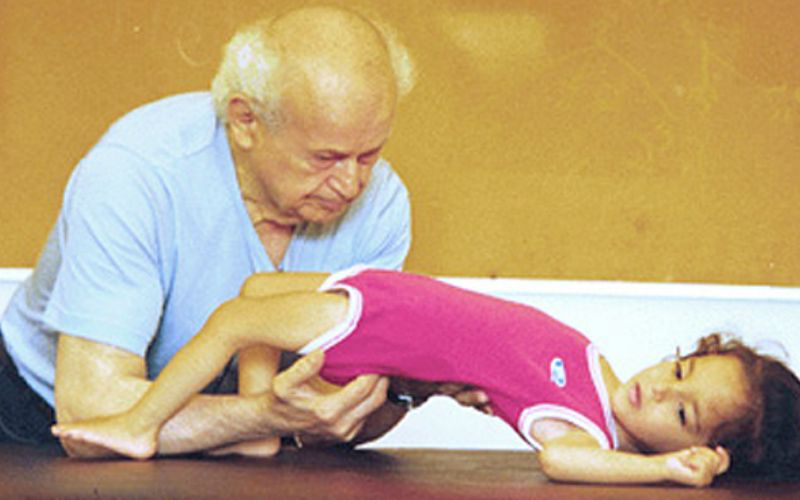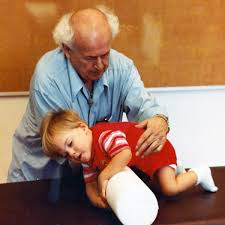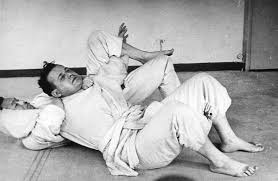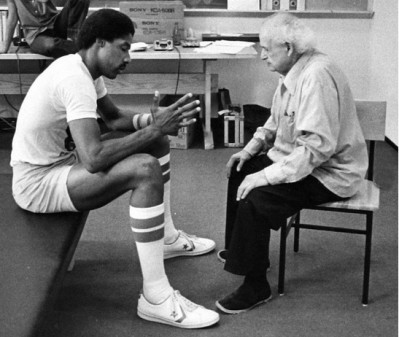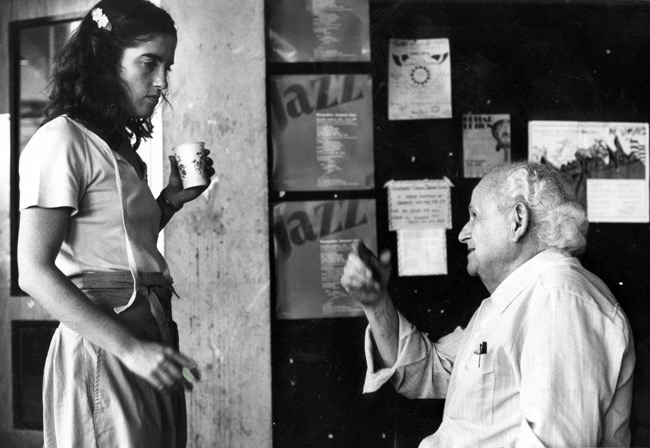ABM Heritage
Please, allow me to introduce you to Moshe Feldenkrais, his masterful learning system The Feldenkrais Method, and one of his prized students and collaborator, my teacher, Anat Baniel.
ABM Neuromovement® is steeped in a heritage rich in ground breaking creative thinking and guided by keen listening skills and profound self awareness. Rooted in fertile multidisciplinary traditions, the Anat Baniel Method counts physics, biomechanics, neurosciences and human development among its sources of inspiration. Oh yes, ABM is also a consequence of Dr. Feldenkrais’ dedication to the martial disciplines of judo and jiu jitsu, and Anat Baniel’s own lifelong passion for movement and dance !
Today’s ABM had its start over a century ago in what was then Palestine, at the end of WWI. A fascinating, intriguing story, my intent is to disclose a limited version, while urging you to follow the links below for more expansive details.
The Feldenkrais Method
The slow, gentle movement sequences used in The Feldenkrais Method® simulate the brain’s ability to learn, to develop body-mind awareness, and to hone observation and listening skills.
It is not a question of eliminating the error ... it is a question of learning. … learning new ways to move, and in the process develop and reorganize the nervous systems and the brain, not fix them.
Moshe Feldenkrais
Refined awareness and a fine-tuned ability to ‘pay attention’ allow us to identify and acknowledge our habitual thought, movement, tension and behavioral patterns. This recognition gives us the power to modify our established routines and consider responses that may serve us better. In essence, the
Feldenkrais Method provides the clarity and flexibility to make choices in everything we do. Some refer to this of choice as genuine freedom.
Through awareness we can learn to move with astonishing lightness and freedom - at almost any age - and thereby improve our living
circumstances, not only physically … but emotionally and spiritually.
Moshe Feldenkrais
The Feldenkrais ‘learning’ Method is designed to help people increase their sensitivity and enhance their awareness in order to live life with greater efficiency, ease and comfort. This system engaged the brain’s ability to change and improve performance decades before the term Brain Plasticity had
even existed !
What I’m after isn’t flexible bodies, but flexible brains… actually what I’m after is to restore people to their human dignity.
Moshe Feldenkrais
Functional Integration® is the term used to describe individual, one to one Feldenkrais Lessons. Lessons taught in group, class-like settings are called Awareness Through Motion®.
Moshe Feldenkrais
Moshe Feldenkrais, Russian born, immigrated to British controlled Palestine in 1918. His subsequent travels to France, Britain, and eventual return to the newly formed state of Israel make for an epic adventure that saw Feldenkrais engage and collaborate with some of the most influential historical figures from the 20th century.
Overall, Feldenkrais’ biography, his endeavors in athletics, physics, bio-mechanics, together with his war time adventures and heroics are truly extraordinary. His real life exploits sound like mythical legends. The monumental, comedic escapades of Winston Groom’s fictitious character Forrest Gump seem to parallel Moshe’s adventurous journey !
Feldenkrais began his immersion into the martial art of Japanese Jiu Jitsu in 1918 after his arrival from eastern Europe. Motivated by the widespread occurrence of street violence between Arabs and Jews. He was to research, explore, teach and practice martial arts throughout his life. He was able to relate the knowledge he gained from this immersion into all his future endeavors. In 1930 he published his first instruction manual for hand to hand combat.
Feldenkrais departed for France to pursue an Engineering Degree that same year. Earning his Doctorate in Physics at the Sorbonne in Paris was his next goal. There, Feldenkrais crossed paths with the legendary Marie Curie, one of his professors. He was soon connected to another Nobel Laureate, Frederic Joliet (Curie’s son-in-law) at the Radium Institute. He served as Joliet’s research assistant.
In 1933 Feldenkrais met, was befriended by, and studied with the founder of Judo, Jigoro Kano. Perceiving that Feldenkrais had the ability and talent to spread judo to the West, Kano provided Moshe with a senior instructor to train Moshe. By the end of the decade Feldenkrais had earned his 2nd degree
black belt, written multiple books, and was regarded as one of Europe’s most respected martial artists. In 1936 he cofounded the Jujitsu Club of France. One of his students became the first Secretary-General of the International Judo Federation (1946).
Meanwhile Dr. Feldenkrais was part of Joliet-Curie’s research team studying nuclear chain reactions and the requirements of building and sustaining a nuclear reactor. In the spring of 1940, Feldenkrais fled to England just ahead of the German invasion. With him he smuggled a jar of heavy water and
sensitive nuclear research material he delivered to the British Navy. During the rest of the war Feldenkrais served as a science officer assigned to develop anti-submarine weaponry and was also employed in training British sailors in hand to hand combat.
Near the end of the war Moshe injured his knee. He blended his scientific methodology with martial arts expertise in his successful quest for healing. His application of personal awareness, bio-mechanics and observation of movement patterns were integral to his process, and would become the basis for his system of movement education.
In 1946 Feldenkrais resigned from the Admiralty and concentrated on his new awareness-oriented movement education system, and of course on judo. He also published his first book on his cutting edge system.
Dr. Feldenkrais returned to what was now the newly minted state of Israel in the early 50s, and was soon appointed the Director of Electronics at the Israeli Defense Forces. There he was involved in the Israeli Nuclear program, and as always, he continued to train troops in hand to hand combat. He also
was diligently developing his learning system based in awareness through movement.
He left the military to teach the Feldenkrais Method full-time in 1957. Among his first clients was the Prime Minister, David Ben-Gurion. Among his future clients he counted another Doctor - DR. J - American basketball immortal Julius Erving, and anthropologists Margaret Mead.
All I can say is “What a life!”
Anat Baniel
Anat Baniel’s father, a scientist that worked at the IDF, was another early student of Moshe Feldenkrais. Legend has it that he volunteered the use of his his home to host movement classes for his mentor. Soon his young daughter was participating in the lessons alongside her dance instructor.
Always pursuing her passion for dance, that little girl grew up, studied Psychology and Statistics at Tel Aviv University, and then attended grad school to study and eventually practice clinical psychology.
Searching for a way to integrate her love of movement and dance into her practice, Anat Baniel made the decision to approach Dr. Feldenkrais.
She graduated from his training program, and then worked and traveled with him until his death in 1985. Anat Baniel continues to this day to explore movement, awareness, and ways to wake up the brain to “transform lives and help people of all ages move beyond pain and limitation” !
Anat’s work and experience as a trainer and movement teacher over the past 40 years has matured and continues to evolve the work started by Moshe Feldenkrais. She has developed cutting edge, breakthrough techniques and unique teacher trainings. She calls the Anat Baniel Method
Neuromovement®.
ABM continues to evolve and to transform limitations into possibilities in remarkable ways! And so does Anat Baniel !
https://www.anatbanielmethod.com/about-abm/about-anat-baniel

